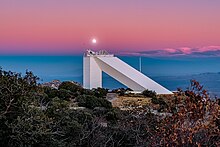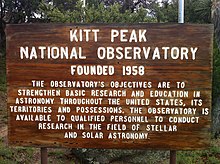Kitt Peak Observatory
Kitt Peak National Observatory was founded in 1958. It is home to what was the largest solar telescope in the world, and many large astronomical telescopes of the late 20th century in the United States.
The observatory was administered by the National Optical Astronomy Observatory (NOAO) from the early 1980s until 2019, after which it was overseen by NOIRLab.
In June 2022, the Contreras Fire led to the evacuation of Kitt Peak. The fire reached the summit at 2 a.m. on Friday, June 17. Four non-scientific buildings, including a dormitory, were lost in the fire. 15 months later in September 2023, the observatory reopened to the public.
General information
Kitt Peak was selected by its first director, Aden B. Meinel, in 1958 as the site for a national observatory under contract with the National Science Foundation (NSF) and was administered by the Association of Universities for Research in Astronomy. The land was leased from the Tohono Oʼodham under a perpetual agreement. The second director (1960 to 1971) was Nicholas U. Mayall. In 1982, NOAO was formed to consolidate the management of three optical observatories — Kitt Peak; the National Solar Observatory facilities at Kitt Peak and Sacramento Peak, New Mexico; and the Cerro Tololo Inter-American Observatory in Chile. The observatory sites are under lease from the Tohono O'odham Nation at the amount of a quarter dollar per acre yearly, which was overwhelmingly approved by the Council in the 1950s. In 2005, the Tohono O'odham Nation brought suit against the National Science Foundation to stop further construction of gamma ray detectors in the Gardens of the Sacred Tohono O'odham Spirit I'itoi, which are just below the summit.
The largest optical instruments at KPNO are the Mayall 4 meter telescope and the WIYN 3.5-meter telescope; there are also several two- and one-meter class telescopes. The McMath–Pierce solar telescope was for many decades the largest solar telescope in the world and the largest unobstructed reflector (no secondary mirror in the path of incoming light). The ARO 12m Radio Telescope is also at the location.
Kitt Peak is famous for hosting the first telescope (an old 91 cm reflector) used to search for near-Earth asteroids, and calculating the probability of an impact with planet Earth.
Kitt Peak hosts an array of programs for the public to take part in, including:
- Daytime tours, speaking about the history of the observatory as well as touring a major research telescope.
- The Nightly Observing Program (NOP), which allows visitors to arrive in the late afternoon, watch the sunset, and use binoculars and telescopes to view the cosmos.
- Additionally, there is the Overnight Telescope Observing Program (OTOP). This program allows for a one-on-one, full night of observing using any of the visitor center's telescopes. Guests may choose to do DSLR imaging, CCD imaging, or simply take in the sights with their eye to the telescope.

Kitt Peak's Southeastern Association for Research and Astronomy (SARA) Telescope was featured in the WIPB-PBS documentary, "Seeing Stars in Indiana". The project followed SARA astronomers from Ball State University to the observatory and featured time-lapse images from various points around Kitt Peak.
A major project started in the 2010s is the Dark Energy Spectroscopic Instrument (DESI) for the 4-meter Mayall telescope, for conducting spectrographic astronomical surveys of distant galaxies probing the expansion history of the universe and the mysterious physics of dark energy.
History

The Kitt Peak National Observatory of the United States was dedicated on March 16, 1960. At the dedication a 36-inch telescope and various facilities were ready. Construction was underway for the then planned 84 inch telescope. (i.e. the KPNO 2.1 meter)
The 84 inch (2.1 m) had its first light in September 1964.
Over the decades the mountaintop hosted many telescopes, and achieved a variety of discoveries. Some examples of astronomical research KPNO contributed to include the study of dark matter, cosmic distances, high-redshift galaxies, and the Boötes Void. In addition, the observatory has engaged in variety of public outreach and education programs.
In 2018, KPNO established plans for its Windows on the Universe Center for Astronomy Outreach.
Notable discoveries

In 1976 the Mayall Telescope was used to discover methane ice on Pluto.
The 90 cm Spacewatch telescope was used to discover the Kuiper belt body, 20000 Varuna in the year 2000. This was discovered by an astronomer noticing the slow moving object in a blink comparison.
Climate
Due to its high elevation, the observatory experiences a subtropical highland climate (Cfb) with a much cooler and wetter climate throughout the year than most of the Sonoran Desert.
Facilities

-
380° panorama of Kitt Peak from the Warner and Swasey Observatory
-
400° panorama from Kitt Peak's Mayall 4-meter Observatory
| Climate data for Kitt Peak, Arizona (Elevation 6,790ft) | |||||||||||||
|---|---|---|---|---|---|---|---|---|---|---|---|---|---|
| Month | Jan | Feb | Mar | Apr | May | Jun | Jul | Aug | Sep | Oct | Nov | Dec | Year |
| Record high °F (°C) | 71 (22) |
75 (24) |
78 (26) |
88 (31) |
90 (32) |
98 (37) |
98 (37) |
94 (34) |
91 (33) |
89 (32) |
87 (31) |
72 (22) |
98 (37) |
| Mean daily maximum °F (°C) | 49.6 (9.8) |
50.8 (10.4) |
54.3 (12.4) |
61.7 (16.5) |
70.4 (21.3) |
79.5 (26.4) |
80.4 (26.9) |
78.0 (25.6) |
74.9 (23.8) |
66.9 (19.4) |
56.8 (13.8) |
50.0 (10.0) |
64.4 (18.0) |
| Mean daily minimum °F (°C) | 33.0 (0.6) |
33.6 (0.9) |
35.8 (2.1) |
41.3 (5.2) |
49.2 (9.6) |
58.5 (14.7) |
60.8 (16.0) |
59.8 (15.4) |
57.0 (13.9) |
48.6 (9.2) |
39.5 (4.2) |
33.7 (0.9) |
45.9 (7.7) |
| Record low °F (°C) | −3 (−19) |
−2 (−19) |
9 (−13) |
15 (−9) |
24 (−4) |
33 (1) |
40 (4) |
42 (6) |
35 (2) |
20 (−7) |
12 (−11) |
6 (−14) |
−3 (−19) |
| Average precipitation inches (mm) | 1.77 (45) |
1.60 (41) |
1.80 (46) |
0.55 (14) |
0.44 (11) |
0.45 (11) |
4.38 (111) |
4.53 (115) |
2.36 (60) |
1.50 (38) |
1.14 (29) |
2.65 (67) |
23.16 (588) |
| Average snowfall inches (cm) | 3.0 (7.6) |
4.3 (11) |
4.1 (10) |
1.2 (3.0) |
0.1 (0.25) |
0.0 (0.0) |
0.0 (0.0) |
0.0 (0.0) |
0.0 (0.0) |
0.3 (0.76) |
1.2 (3.0) |
3.8 (9.7) |
18.1 (46) |
| Source: The Western Regional Climate Center | |||||||||||||
See also
- List of astronomical observatories
- List of radio telescopes
- List of telescope types
- Richard Green (astronomer)
References
- ^ "ABOUT". SARA. Retrieved May 19, 2023.
- ^ National Optical Astronomy Observatory (NOAO). "Kitt Peak National Observatory". Retrieved February 18, 2012.
- ^ Lang, Kenneth R. (January 15, 2007). A Companion to Astronomy and Astrophysics: Chronology and Glossary with Data Tables. Springer Science & Business Media. ISBN 9780387333670.
- ^ Clery, Daniel (October 31, 2019). "U.S. telescopes get a new overseer". Science. Retrieved November 18, 2019.
- ^ "Arizona Wildfire Destroys Observatory Buildings". New York Times. June 20, 2022. Retrieved June 20, 2022.
- ^ Borla, Charles (September 23, 2023). "Kitt Peak National Observatory reopens after COVID, wildfire". tucson.com. Tucson, Arizona. Retrieved December 10, 2024.
- ^ "Astronomy development on another sacred mountain: Kitt Peak". Archived from the original on August 20, 2008. Retrieved February 16, 2009.
- ^ The Daniel K. Inouye Solar Telescope is now the largest.
- ^ "The Spacewatch Project". Retrieved December 13, 2017.
- ^ "Kitt Peak Visitor Center Tours, Stargazing, Programs, and Exhibits". Retrieved June 2, 2022.
- ^ Kevin Grazioli (director) (2011). Grant Keller (ed.). Seeing Stars In Indiana. Retrieved February 17, 2012.
- ^ Bebek, C.J., ed. (June 15, 2015). "DESI Design Report". Retrieved February 12, 2016.
- ^ Pultarova, Tereza (February 16, 2018). "How 5,000 Pencil-Size Robots May Solve the Mysteries of the universe". Live Science.
- ^ "General Notes". Publications of the Astronomical Society of the Pacific. 72 (425): 146. 1960. Bibcode:1960PASP...72..146.. doi:10.1086/127502.
- ^ "2.1-Meter Telescope". www.noao.edu. Archived from the original on September 4, 2019. Retrieved November 22, 2019.
- ^ Science, Elizabeth Howell 2014-08-21T02:46:09Z; Astronomy (August 21, 2014). "Kitt Peak National Observatory: Discoveries & Programs". Space.com. Retrieved November 18, 2019.
{{cite web}}: CS1 maint: numeric names: authors list (link) - ^ "NSF Funds New Center for Astronomy Outreach at Kitt Peak". www.spaceref.com. September 26, 2018. Retrieved November 18, 2019.
- ^ Leverington, David (May 29, 2003). Babylon to Voyager and Beyond: A History of Planetary Astronomy. Cambridge University Press. ISBN 9780521808408.
- ^ "Spacewatch Discovery of Minor Planet 2000 WR106 | SPACEWATCH®". spacewatch.lpl.arizona.edu. Retrieved November 10, 2019.
- ^ "Seasonal Temperature and Precipitation Information". Western Regional Climate Center. Retrieved December 6, 2014.
Further reading
- Discover Magazine article about Kitt Peak, May 2005
- Kitt Peak docent training book, 2008 Archived June 8, 2011, at the Wayback Machine
External links
- Kitt Peak National Observatory Visitor Center – visiting and tour information
- Kitt Peak Webcam
- Kitt Peak Clear Sky Chart Forecasts of observing conditions
- NOAA general forecast for KPNO
- NOAA detailed forecast for KPNO
- Observing At Kitt Peak – General Overview for Observers and Staff


